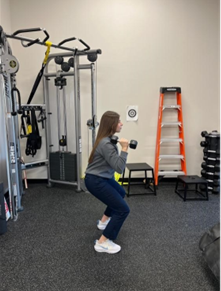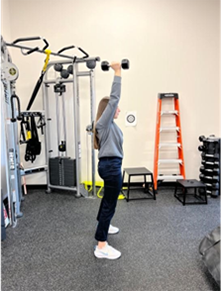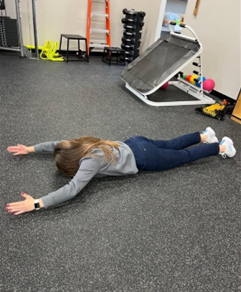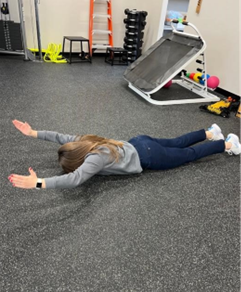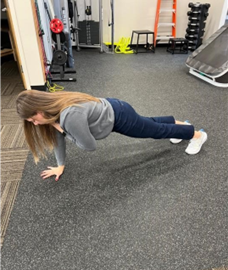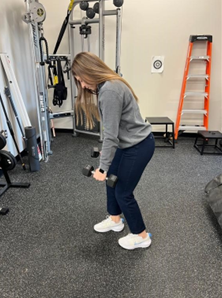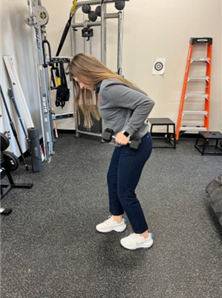
Shoulder Stability for Cheerleaders
Leave a CommentCo-author: Megan Partain, SPT
Have you ever wondered how your favorite cheerleaders spend hours tumbling, stunting, and holding each other up in the air? Well, in cheerleading, it comes down to a little more than just sheer talent but incredibly strong and stable shoulders. Athletes with decreased shoulder strength are prone to injuries like dislocations, sprains, and strains. Current research suggests that regular shoulder strengthening exercises can help prevent these types of injuries. The following exercises are recommended for tumblers and especially indicated for main and instep bases, as well as back spots.
For each exercise that requires a dumbbell, athletes should select a weight that is light enough to perform at least 6 repetitions (reps), but heavy enough that completing more than 8 reps would be difficult with proper form. The ideal weight allows the athlete to perform 6-8 reps per set. Each exercise should be completed for 3 sets of 6-8 reps. With the practice of the following exercises, an athlete can increase their reps and weight over time as they gain strength. This method of training is known as progressive overload for increases in strength.
1. Squat to Shoulder Press
For this exercise, begin by holding the dumbbell close to the shoulder. While descending into a squat, ensure the back remains straight and knees are in line with the toes. Rising back to standing, press the dumbbell overhead. If the dumbbell does not remain steady and the arm begins to sway, this is a sign that the selected weight may be too heavy. This exercise works the muscles required to lift a flyer into overhead stunts.
2. Superman
Begin by lying on the floor face down, with arms overhead resting on the floor. For a 30-second hold, lift the arms off the floor, engaging the shoulder and back muscles, relaxing the neck, squeezing the shoulder blades together, and tightening your gluteal muscles to protect your lower back. Repeat this exercise 3-4 times each with a 30-second hold. This exercise works to increase scapular stability for increased overhead control. No more shaky shoulders when holding your flyer up!
3. Plank Shoulder Taps
For this exercise, start in an extended plank position. Pick up one hand and tap it to the opposite shoulder without shifting body weight. Continue alternating shoulder taps. This exercise can be completed for 30-60 seconds and repeated 3-4 times. It targets shoulder strength for blocking to make powerful tumbling passes.
4. Dumbbell Rows
Begin this exercise with the arms down at the sides of the body and in a modified tandem stance, with knees and hips slightly bent, as seen in the photo. Pull the dumbbells upwards towards the chest, drawing the elbows back and keeping the arms close to the sides of the body. This exercise should be performed slowly and with control. This exercise is great for shoulder and arm strengthening and will decrease the risk of injury with stunting and tumbling.
These exercises should be integrated into an athlete’s training regimen and performed 3-4 times per week to increase shoulder strength and stability. Regularly completing strength and stability exercises can help decrease injury risk with stunting and tumbling activities and keep athletes healthy during cheerleading practice and competitions. Contact your local Athletico for a free assessment if you have any questions about potential shoulder injuries.
*Per federal guidelines, beneficiaries of plans such as Medicare, Medicaid, Tricare, VHA and other federally funded plans are not eligible for free assessments.
The Athletico blog is an educational resource written by Athletico employees. Athletico bloggers are licensed professionals who abide by the code of ethics outlined by their respective professional associations. The content published in blog posts represents the opinion of the individual author based on their expertise and experience. The content provided in this blog is for informational purposes only, does not constitute medical advice and should not be relied on for making personal health decisions.
References:
1. Kevin G. Laudner, Betsy Metz, David Q. Thomas; Anterior Glenohumeral Laxity and Stiffness After a Shoulder-Strengthening Program in Collegiate Cheerleaders. J Athl Train 1 January 2013; 48 (1): 25–30. doi:https://doi.org/10.4085/1062-6050-47.6.03
